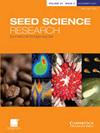Seed traits and phylogenomics: prospects for the 21st century
IF 1.9
3区 生物学
Q2 PLANT SCIENCES
引用次数: 1
Abstract
Abstract Genetic and biochemical studies have greatly advanced our understanding of the biology of seeds in recent years. Another area of study, which could accelerate contemporary seed biology research, is phylogenomics that integrates the wealth of genome sequence data with evolutionary biology. The recent phylogenomic study of the DELAY OF GERMINATION1 family genes exemplifies how the molecular evolution of seed genes can be traced back through early diverging plants and what implications can be obtained from the analysis of seed gene diversification at ancient times. The identification of possible ancestors of seed genes in non-seed plants could illuminate the ancient roots of the molecular mechanisms driving seed maturation programmes. It is possible that the origins of molecular mechanisms associated with the induction of seed storage proteins and desiccation tolerance proteins date back to the time of, or even prior to, early diverging land plants. Abscisic acid-dependent growth arrest or dormancy mechanisms might date back to red algae, one of the oldest algal groups. Thus, understanding algal cell biology will also be an integral part of future seed biology research. Unravelling key events associated with the evolution of seed- and non-seed plants will not only advance basic research but could also contribute to applied aspects of seed science, potentially leading to technology development for agriculture.21世纪种子性状与系统发育学展望
摘要近年来,遗传学和生物化学研究极大地促进了我们对种子生物学的理解。另一个可以加速当代种子生物学研究的研究领域是系统发育学,它将丰富的基因组序列数据与进化生物学相结合。最近对繁殖延迟1家族基因的系统发育学研究表明,种子基因的分子进化可以追溯到早期分化的植物,以及从古代种子基因多样性的分析中可以获得什么启示。在非种子植物中鉴定种子基因的可能祖先,可以阐明驱动种子成熟程序的分子机制的古老根源。与种子储存蛋白和干燥耐受蛋白的诱导相关的分子机制的起源可能可以追溯到早期分化陆地植物的时代,甚至更早。脱落酸依赖的生长停滞或休眠机制可能可以追溯到最古老的藻类之一红藻。因此,了解藻类细胞生物学也将是未来种子生物学研究的组成部分。解开与种子植物和非种子植物进化相关的关键事件不仅将推进基础研究,还可能有助于种子科学的应用方面,有可能促进农业技术的发展。
本文章由计算机程序翻译,如有差异,请以英文原文为准。
求助全文
约1分钟内获得全文
求助全文
来源期刊

Seed Science Research
生物-植物科学
CiteScore
3.60
自引率
4.80%
发文量
23
审稿时长
>12 weeks
期刊介绍:
Seed Science Research, the official journal of the International Society for Seed Science, is a leading international journal featuring high-quality original papers and review articles on the fundamental aspects of seed science, reviewed by internationally distinguished editors. The emphasis is on the physiology, biochemistry, molecular biology and ecology of seeds.
 求助内容:
求助内容: 应助结果提醒方式:
应助结果提醒方式:


